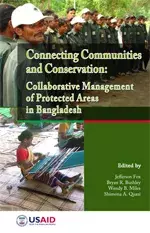Error message

Bangladesh has one of the highest population densities and one of the lowest levels of protected area coverage in the world. As a result, sustainable natural resource management and biodiversity conservation are critical issues. To address these issues, the Nishorgo Support Project was launched in 2003 as an undertaking of the Forest Department of Bangladesh, with financial and technical support from USAID. The overall goal of the Nishorgo Support Project is to enhance biodiversity conservation in targeted protected areas through the active and formal involvement of local communities dependent on forest resources.
This book is the second of two volumes investigating recent and ongoing initiatives for the co-management of natural resources being implemented by the Nishorgo Support Project. The first volume investigated issues of rural livelihoods near protected areas selected as pilot co-management sites by the Nishorgo Support Project. This current volume illustrates that the co-management of natural resources and protected areas occurs on multiple levels. The authors show that although community-based natural resource management is still in its infancy in Bangladesh, measurable improvement has been made in terms of poverty reduction, gender equity, resource dependence, and income-earning opportunities. However, co-management is not only about allowing local citizens to participate in forest management activities and share in the benefits that these activities produce; local users and stakeholders must also have the ability to influence the decisions that affect their livelihoods and their access to resources. It is in this area of participation that many issues remain to be addressed. Lack of local stakeholder input afflicts not only the governance machinery in place for co-management (i.e., the structure of the councils, committees, and forest user groups), but also the biological and social monitoring process, and the means by which PA benefits are distributed and selected.
The two volumes were produced under a joint applied research project of the Nishorgo Support Project and the East-West Center (Honolulu, Hawaii). Through this project a series of workshops were arranged in 2006 and 2007 to engage Bangladeshi researchers in developing research proposals and conducting field studies in any of the pilot protected areas, and to write up their results. The overall objective of this research initiative was to encourage the Forest Department and local academic institutions to conduct applied research in order to support the design of new and more appropriate management plans and policies for protected areas in Bangladesh. The applied research process was led by Dr. Jefferson Fox of the East-West Center (Honolulu, Hawaii) in collaboration with the Nishorgo Program of the Bangladesh Forest Department. This research effort was financed by the Government of Bangladesh and USAID. The Nishorgo Support Project receives technical assistance from IRG of Washington DC/USA and its partner NGOs, CODEC, RDRS, NACOM and IUCN/Bangladesh.
Bangladesh has one of the highest population densities and one of the lowest levels of protected area coverage in the world. As a result, sustainable natural resource management and biodiversity conservation are critical issues. To address these issues, the Nishorgo Support Project was launched in 2003 as an undertaking of the Forest Department of Bangladesh, with financial and technical support from USAID. The overall goal of the Nishorgo Support Project is to enhance biodiversity conservation in targeted protected areas through the active and formal involvement of local communities dependent on forest resources.
This book is the second of two volumes investigating recent and ongoing initiatives for the co-management of natural resources being implemented by the Nishorgo Support Project. The first volume investigated issues of rural livelihoods near protected areas selected as pilot co-management sites by the Nishorgo Support Project. This current volume illustrates that the co-management of natural resources and protected areas occurs on multiple levels. The authors show that although community-based natural resource management is still in its infancy in Bangladesh, measurable improvement has been made in terms of poverty reduction, gender equity, resource dependence, and income-earning opportunities. However, co-management is not only about allowing local citizens to participate in forest management activities and share in the benefits that these activities produce; local users and stakeholders must also have the ability to influence the decisions that affect their livelihoods and their access to resources. It is in this area of participation that many issues remain to be addressed. Lack of local stakeholder input afflicts not only the governance machinery in place for co-management (i.e., the structure of the councils, committees, and forest user groups), but also the biological and social monitoring process, and the means by which PA benefits are distributed and selected.
The two volumes were produced under a joint applied research project of the Nishorgo Support Project and the East-West Center (Honolulu, Hawaii). Through this project a series of workshops were arranged in 2006 and 2007 to engage Bangladeshi researchers in developing research proposals and conducting field studies in any of the pilot protected areas, and to write up their results. The overall objective of this research initiative was to encourage the Forest Department and local academic institutions to conduct applied research in order to support the design of new and more appropriate management plans and policies for protected areas in Bangladesh. The applied research process was led by Dr. Jefferson Fox of the East-West Center (Honolulu, Hawaii) in collaboration with the Nishorgo Program of the Bangladesh Forest Department. This research effort was financed by the Government of Bangladesh and USAID. The Nishorgo Support Project receives technical assistance from IRG of Washington DC/USA and its partner NGOs, CODEC, RDRS, NACOM and IUCN/Bangladesh.




